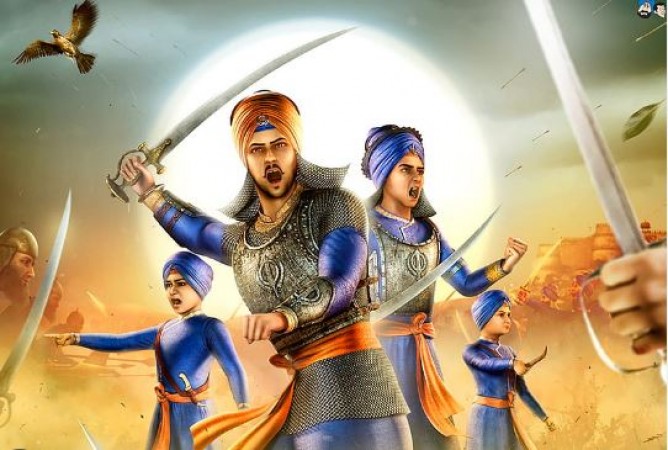
The four sons of Guru Gobind Singh Ji Sahibzaase Ajit Singh Ji the eldest one, Sahibzaade Jujhar Singh Ji the second one, Sahibzaade Zorawar Singh Ji the younger one, the youngest one Sahibzaade Fateh Singh Ji were martyred during the 18th century in a battle against the Mughal Empire.
The world has been celebrating Christmas and is preparing for the New Year but Sikhs across the Globe have been remembering the sacrifice of Chaar Sahibzaade. These days hold a special memory in the mind and heart of every Sikh and they they remember the Chaar Sahibzaade with great vigor and very acute sadness.
And the younger pair called Chotte Sahibzaade were martyred together by Mughals in Sirhind at the tender age of 6 and 9 years old.
The older sahibzaade called Vaade Shibzaade died fighting the enemy of many thousand at the young age of 18 and 14 years old in battle at Chamkaur Sahib.
Guru Sahib, the four Sahibzaade, Mata Gujari Kaur, Guru’s Mahil, Mata Jeeto Ji, his wife, the five Panj Piaras, and a few hundred Sikhs left Anandpur Sahib on the chilly night of 20 December 1704 towards Ropar.
Also Read: Gurudwara Bangla Sahib: Raja Jai Singh Bungalow To Shrine
The Mughals broke their promise and assaulted the Guru's company on the night of December 20–21 at a location on the Sarsa rivulet some 25 kilometers from Anandpur Sahib. The Guru's family was split up and dispersed. The area is now referred to as "Pariwar Vichhora," and a Gurudwara Sahib named "Gurudwara Pariwar Vichhora Sahib" was constructed there in their honor. Bhai Mani Singh and Guru's Mahil headed for Delhi.
Guru Gobind Singh Ji with two elder Sahibzaade, 5 Panj Piaras, and 40 Sikhs proceeded towards Chamkaur and reached there on the afternoon of 21 December.
The famous Chamkaur battle, also known as the Battle of Chamkaur Sahib, was a battle fought between the Khalsa, that took place on December 22 and the older Sahibzaade, called the ‘Vaada Sahibzaade’, who attained martyrdom while fighting the powerful and very well-equipped Mughal army comprising of thousands at the young age of 18 and 14 years old respectively. Three Panj Piaras and 40 Sikhs laid down their lives fighting the 10 lakh-strong mighty Mughal army.
Also Read: Birth Anniversary Of Guru Rinpoche in Bhutan in 2023, June 28
During the battle, Guru Ji’s two youngest sons, Zorawar and Fateh, and their grandmother Mata Gujri Ji got separated from the rest of the Sikhs.
A former servant, Gangoo, a Kashmiri pandit, from his house, saw them and suggested that they come with him to his village. They were grateful for his help and went with him. However, the servant breached their trust and in greed for money, disclosed their location to the Mughals. The Mughals came to the house and captured them.
All three were held captive in the Open Tower (Thanda Burj), where they slept on strands of straw during the bitterly cold winters. The sons were delivered to Wazir Khan, the state's governor. Wazir Khan had faith in the plans of Emperor Aurangzeb. The Sahibzaade was informed by Wazir Khan that if they converted to Islam, he would spare their deaths.
Also Read: Gurudwara Takht Sri Harmandir Patna Sahib
The two Sahibzaade refused to convert to Islam even at such a young age, remaining faithful and firm to the Khalsa Panth. Wazir Khan thereupon gave the order to build a brick wall around them. By being buried alive in bricks, the two Sahibzaade gained martyrdom. When Mata Gujar Kaur learned that her baby grandsons had been martyred, she was unable to handle the trauma and left that day for her heavenly abode.
Also Read: Gurudwara Sri Paonta Sahib
A horrific and cold-blooded atrocity was performed in the Sarzameen of Sirhind on December 27, 1704. The Mughals executed the younger pair, known as the "Chotta Sahibzaade," in Sirhind when they were just 6 and 9 years old. In Fatehgarh Sahib, Punjab, India, this location is currently referred to as "Jyoti Swaroop Gurudwara Sahib.
Also Read: Hemkund Sahib: Highest Gurudwara In World Guru Purnima - Respect to our Gurus